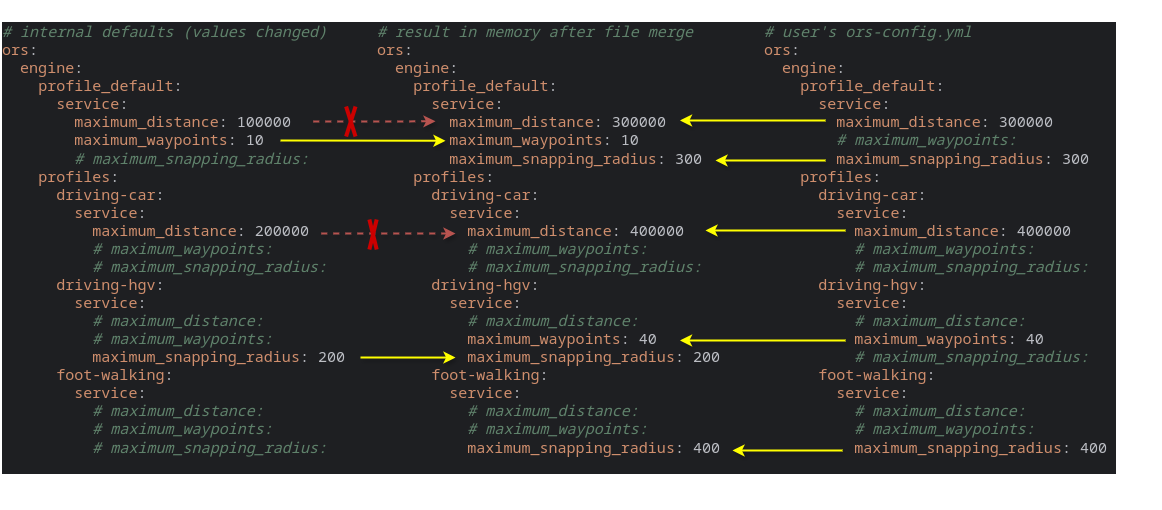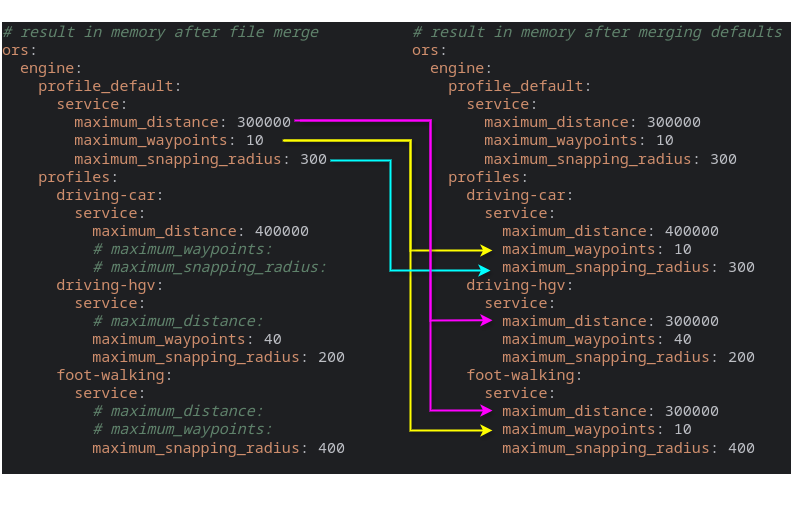Appearance
How to configure openrouteservice
In this chapter we handle different dimensions of the configuration topic:
- Different Notations for the same configuration properties
- Internal defaults: Where are those defined, how to view the internal default values
- Different ways to set individual Values
- Place a Default Config File named
ors-config.ymlin one of the directories where openrouteservice looks for it - or specify a Custom Config File
- override properties with Environment variables in the shell or in an environment file
- override properties with JVM Program Arguments
- override properties with Spring Run Arguments
- Priority of these different property sources
- Place a Default Config File named
- Docker Scenarios
- Defining defaults for all routing profiles in
ors.engine.profile_default - Graph build properties loaded from graph directories
Different Notations
The configuration of openrouteservice can be specified in different notations. Which format to best use in which scenario is documented in the config documentations for JAR, WAR and Docker.
.ymlis the default configuration format since version 8. You can find an example configuration file with all available configuration options. Only a minimal set of properties is active, all others are commented out..envfiles for Docker setup. There is also an example env file that you can download and customize..jsonconfig file: In the past openrouteservice was configured via JSON file. This configuration method has been deprecated and removed in ORS version 9. Therefore, we strongly discourage you from using it. If you have an old JSON config, please consider to migrate to the new config.
All of the above described config files can contain the same logic application properties.
For example, the property ors.engine.profiles.car.enabled would look like this
in *.yml
yaml
ors:
engine:
profiles:
driving-car:
enabled: truein *.env one of
shell
ors.engine.profiles.driving-car.enabled=true
ORS_ENGINE_PROFILES_DRIVING_CAR_ENABLED=trueas Spring or JVM run parameter
shell
ors.engine.profiles.driving-car.enabled=trueTIP
In this documentation we mostly use the dot notation to name a configuration property because it is more compact than e.g. YAML style with line breaks and indentation and better readable than uppercase-underscore environment variable style.
Internal Defaults
openrouteservice has sensible defaults and can be started with a minimal configuration, see What to configure. The internal default values are defined in the file ors-api/src/main/resources/application.yml.
Besides default values for most configuration properties, there are also default routing profiles for all supported modalities with sensible defaults for each of them. These default profiles have the names of their flag encoders. For more details see profiles.
The openrouteservice releases also contain downloadable example ors-config.yml and ors-config.env files as release assets, where all properties with their defaults are included as commented lines.
Configuration defaults output
Since version 9.0.0, openrouteservice offers the option to output the default configuration at startup. This can be useful for debugging purposes, or to generate a template for a custom configuration file containing all defaults. To enable this feature, set the parameter ors.engine.config_output to the target file name before starting openrouteservice. The output will be written to a file of that name, the extension .yml will be added if not supplied.
yaml
ors:
engine:
config_output: ors-config-example.ymlAlternative ways to set this option are Spring runtime parameters, Java VM runtime parameters or environment variables as described above apply. All the following commands can be used to the same effect:
- Spring runtime parameters:
shell
java -jar ors.jar --ors.engine.config_output=ors-config-example.yml- JVM runtime parameters:
shell
java -jar -Dors.engine.config_output=ors-config-example.yml ors.jar- Environment variables:shellor
export ors.engine.config_output=ors-config-example.yml java -jar ors.jarshellexport ORS_ENGINE_CONFIG_OUTPUT=ors-config-example.yml java -jar ors.jar
Hint
The exported file contains the internal defaults, NOT the merge result of all used configuration sources!
Different ways to set individual Values
Custom configuration properties can be set with configuration files, environment variables and start parameters:
Default Config File
If no config location is specified (see below), openrouteservice is looking for a configuration file named ors-config.yml in the locations below in that order. The first existing file (and only this one) is used as configuration source.
| Path | Description |
|---|---|
./ors-config.yml | Current working directory |
~/.config/openrouteservice/ors-config.yml | User configuration directory |
/etc/openrouteservice/ors-config.yml | Global configuration directory |
When openrouteservice is running in a container, these directories are checked inside the container, files from outside the container can be mounted.
TIP
On application start openrouteservice logs which configuration file was loaded. If running inside a container, the printed path is the internal one.
Custom Config File
openrouteservice can also use different yml files than ors-config.yml as configuration source. There are two ways to provide openrouteservice the location of a custom configuration file:
- Program argumentshell
java -jar ors.jar /path/to/my-ors-config.yml - Environment variable
ORS_CONFIG_LOCATIONshellexport ORS_CONFIG_LOCATION=/path/to/my-ors-config.yml java -jar ors.jar
If both are specified, the program argument wins. When a custom config file is used, ors-config.yml files are ignored.
Environment Variables
All or single configuration parameters can be overridden/defined as environment variables.
shell
export ors.engine.profile_default.build.source_file=./osm_file.pbf
export ors.engine.profiles.driving-car.enabled=true
java -jar ors.jarThis is especially useful in contexts where you want to run openrouteservice in containers such as with docker.
Every property also corresponds to an environment variable name in uppercase letters and with underscores replacing dots, so e.g.
ORS_ENGINE_PROFILE_DEFAULT_BUILD_SOURCE_FILEreplacesors.engine.profile_default.build.source_fileORS_ENGINE_PROFILES_CAR_ENABLEDreplacesors.engine.profiles.car.enabled
Consequently, the following commands are equivalent to the last example above:
shell
export ORS_ENGINE_PROFILE_DEFAULT_BUILD_SOURCE_FILE=./osm_file.pbf
export ORS_ENGINE_PROFILES_CAR_ENABLED=true
java -jar ors.jarNote, that there are different ways to define environment variables, e.g. in docker compose files or env files or in setenv.sh files in tomcat setups.
JVM Program Arguments
All or single configuration parameters can be overridden/defined as JVM run arguments:
shell
java -jar -Dors.engine.profile_default.build.source_file=./osm_file.pbf -Dors.engine.profiles.driving-car.enabled=true ors.jarSpring Run Arguments
All or single configuration parameters can be overridden/defined as Spring run arguments:
shell
java -jar ors.jar --ors.engine.profile_default.build.source_file=./osm_file.pbf --ors.engine.profiles.driving-car.enabled=truePriority of these different property sources
If properties are set in several configuration sources, the priority is as follows. 1 (highest priority) to 5 (lowest):
- Spring Run Arguments override
- JVM Program Arguments override
- Environment Variables override
- Properties defined in the single used config file override
- Internal defaults
The following image illustrates, how a config yml overrides some of the internal defaults. The merge result is shown in the middle. The red lines are examples for properties defined on both sides - the user config wins. The commented lines (green) are just included for better readability.

Docker Scenarios
An openrouteservice instance running in a container works in the same way as described in this chapter. The difference is, that openrouteservice has a docker container as its environment, with a separate file system (different paths) and individual environment variables. The lookup for configuration files is always related to the internal environment, this has to be respected when configuring paths in the YAML config or when specifying the config file in the parameter ors_config_location.
Like in a "normal" setup, all configuration properties can be set as environment variables. This is a more common way for configuring applications in docker containers, in contrast to applications running directly on the host system, because in the docker container there is a fresh and independent environment.
Running with Docker describes in detail, how openrouteservice can be configured in docker scenarios.
Defining defaults for all routing profiles
Besides the overriding mechanisms of different configuration sources, there is also a way to define defaults for all (enabled) routing profiles:
The structure nested in ors.engine.profile_default is the exact same as in each routing profile in ors.engine.profiles. Each specific routing profile inherits the defaults from profile_default and can override or add single properties.
It is important to understand, that ors.engine.profile_default and ors.engine.profiles are itself configuration properties and like all other properties in the hierarchical structure of configuration properties are first merged from all configuration sources. The final merge results of these properties are then the base for the internal logic of the defaults for profiles:

One side effect is, that properties of specific profiles, that are defined in the internal defaults, cannot be overridden by properties in the user's profile_default! In the example above the user has defined ors.engine.profile_default.maximum_snapping_radius: 300 but the profile foot-walking has an internal default 400 for this property. The internal value for the specific profile wins over the user's profile_default:

Graph build properties loaded from graph directories
The configured profile properties in ors.engine.profiles.<PROFILE-NAME>.build (and ors.engine.profile_default.build) are used to build a graph. openrouteservice stores these build properties in the file graphs/<profile>/graph_build_info.yml when a graph is computed.
When openrouteservice is loading an existing graph instead of building it, the persisted build parameters are again loaded from this file, locally configured build parameters for the affected routing profile are overridden.
Therefore, the file graph_build_info.yml must not be edited! The content of this file is also used for repository lookups by the (Graph Repo Client).

